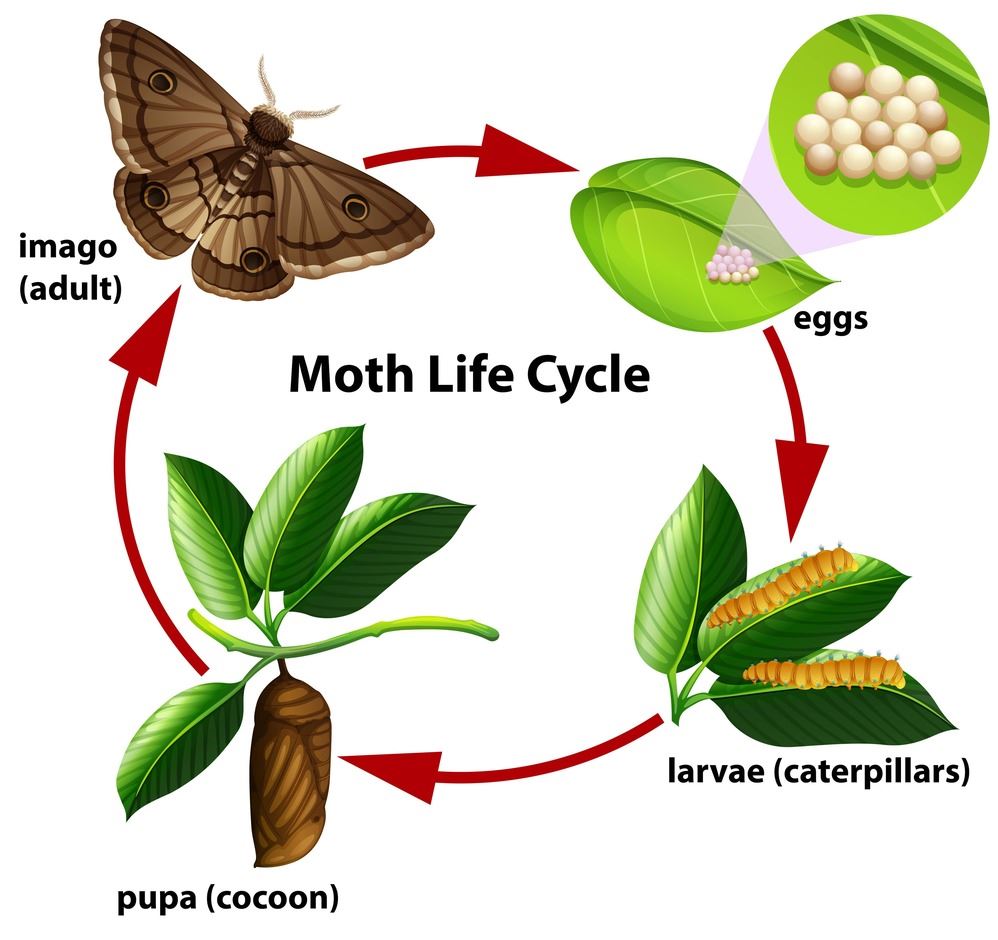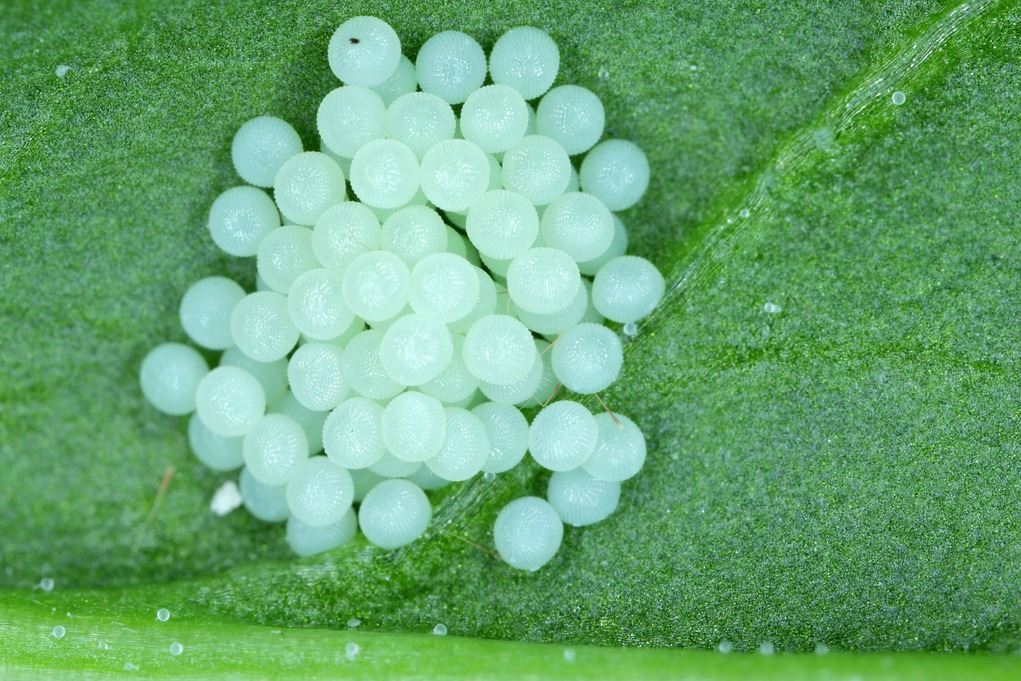Moths are a varied and widespread group of insects closely related to butterflies. Both belong to the order Lepidoptera. They play a significant role in the ecosystem as pollinators, and their larvae, commonly known as caterpillars, can be beneficial and harmful depending on the species. In this article, learn about what moth larvae but also what moth eggs look like so you know if you will have an infestation on your hands.
Let’s learn more!
What are Moths?
Moths are nocturnal or crepuscular insects that are attracted to light at night. There are approximately 160,000 species of moths, many of which have yet to be described. Their life cycle includes four stages: egg, larva (caterpillar), pupa (cocoon), and adult.
Impact of Moth Larvae
Moth larvae, commonly known as caterpillars, can have a significant impact on their environment, both positive and negative. The extent of their impact largely depends on the species and the ecosystem in which they are found.
Positive Impacts
- Pollination: Some moth larvae develop into adult moths that serve as pollinators for many plants, contributing to the health of ecosystems and the production of fruits and seeds.
- Food Source: Moth larvae are an essential part of the food chain, providing nourishment for a variety of predators including birds, bats, reptiles, amphibians, and other insects.
- Soil Enrichment: The waste produced by larvae, as well as their decomposition after death, contributes organic matter to the soil, enriching it and promoting plant growth.
Negative Impacts
- Agricultural Damage: Many species of moth larvae are considered pests in agriculture. They can cause extensive damage to crops by feeding on leaves, stems, fruits, and roots. For example, the cabbage looper (Trichoplusia ni) targets brassica crops, while corn earworms (Helicoverpa zea) attack a wide range of vegetables and grains.
- Fabric and Material Damage: Larvae of clothes moths (e.g., Tineola bisselliella and Tinea pellionella) feed on natural fibers such as wool, silk, feathers, and fur, damaging clothing, upholstery, and carpets.
- Stored Product Infestation: Pantry moths like the Indianmeal moth (Plodia interpunctella) and the Mediterranean flour moth (Ephestia kuehniella) infest stored grains and processed products, leading to food loss and contamination.
- Forestry Impact: Some moth larvae, such as the gypsy moth (Lymantria dispar), are known for defoliating trees, which can weaken or kill the trees and disrupt forest ecosystems.
- Health Risks: Certain moth larvae have hairs or spines that can cause allergic reactions, skin irritation, or respiratory problems in sensitive individuals.
The impact of moth larvae is diverse and context-dependent. While they play an integral role in natural ecosystems, their presence in human-dominated environments often necessitates management strategies to mitigate their potential for harm.
Take a look below at the life cycle of the moth. This allows you to see the process of starting with the moth egg, caterpillar, cocoon, and adult moth.

What Do Moth Eggs Look Like?
Moth eggs are typically tiny and may not be easily noticed without a deliberate search. They can be spherical or oval in shape and are often found in clusters. The color of moth eggs varies by species but commonly they range from white to off-white or gray. Some moth eggs have a pearl-like glossy look, while others blend into their surroundings.
The size of moth eggs is generally quite small, typically around 1 mm in diameter, which is roughly the size of a pinhead. Moth eggs may look like they are individual but they are more commonly laid in clusters. The surface may be smooth or textured with ridges or bumps. It’s not uncommon for them to have a shiny or matte finish.
Where Do You Find Moth Eggs?
Moth eggs are often located on the undersides of leaves, in closets, on woolen fabrics, or in other sheltered places where the female moth finds it suitable to lay her eggs. The location is usually chosen based on the food sources available for the larvae upon hatching.
What Are the Most Common Moth Species?
The most common moth species vary by region, but some have a widespread presence due to their adaptability and the global trade of goods. Here are a few of the most commonly encountered moth species:
Clothes Moths
- Tineola bisselliella (Common Clothes Moth): This species is notorious for damaging woolen fabrics, furs, and other materials. They are small, with a wingspan of about 12-15 mm, and light golden in color.
- Tinea pellionella (Case-Bearing Clothes Moth): Slightly larger than the common clothes moth, these moths are known for the cases that their larvae carry around as they feed.
Pantry Moths
- Plodia interpunctella (Indianmeal Moth): Often found in pantries, this moth’s larvae infest grains, nuts, and dried fruits. Additionally, The adults have a distinctive wing pattern with a pale base and reddish-brown tips.
- Ephestia kuehniella (Mediterranean Flour Moth): Another pest of grain products, this moth has pale gray wings with wavy black lines.
Garden Moths
- Noctua pronuba (Large Yellow Underwing): A common moth in gardens, the large yellow underwing has brown forewings and bright yellow hindwings with a black band at the edge.
- Trichoplusia ni (Cabbage Looper): Known for its larvae that loop as they move, this moth affects various crops including cabbage, tomatoes, and potatoes.
Household Moths
- Lymantria dispar (Gypsy Moth): While not typically a household moth, the gypsy moth is well-known for its destructive larvae which can defoliate trees in large numbers.
- Hofmannophila pseudospretella (Brown House Moth): Commonly found indoors, this moth has a cosmopolitan distribution and feeds on a wide range of organic materials.
These species represent just a fraction of the diversity within the moth population. Each species has unique characteristics and life cycles. This can affect their prevalence and the type of control measures needed to manage them. Also, moths have mouths that are coiled tube-like structure called proboscis. This proboscis acts as a straw-like appendage for feeding on nectar or other liquid food sources.

Preventative Measures
Preventative measures against moth infestations are essential to protect your home, clothing, and pantry items from the damage that moths and their larvae can cause. Here are some strategies to prevent moths from becoming a problem:
Clothes Moths:
- Clean Clothing: Ensure that clothes, especially those made of natural fibers like wool and silk, are clean before storing them, as moths are attracted to sweat, oils, and food stains.
- Proper Storage: Store clothing in airtight containers or garment bags to prevent moths from laying eggs on the fabric.
- Cedar and Lavender: Use natural repellents such as cedar blocks, chips, or lavender sachets in closets and drawers, as these scents can deter moths.
- Regular Vacuuming: Frequently vacuum carpets, rugs, and upholstered furniture to remove any eggs or larvae.
- Moth Traps: Place pheromone traps in closets to catch adult males and reduce the breeding population.
Pantry Moths:
- Seal Food Containers: Store grains, flours, nuts, and dried fruits in airtight containers to prevent access by moths.
- Regular Cleaning: Clean pantry shelves regularly to remove food residues that could attract moths.
- Inspect Groceries: Check new grocery items for signs of moth infestation before bringing them into your home.
- Dispose of Infested Products: If you find an infested item, dispose of it immediately in a sealed bag outside your home. This will prevent the spread of larvae.
- Bay Leaves: Some people use bay leaves in their pantry as a natural deterrent, although its effectiveness is anecdotal.
Garden and Agricultural Moths:
- Garden Hygiene: Remove plant debris and weeds from the garden to eliminate potential breeding sites.
- Crop Rotation: Rotate crops each year to disrupt the life cycle of moths that prefer specific plants.
- Barriers and Nets: Use floating row covers or netting to physically block moths from reaching plants.
- Beneficial Insects: Encourage or introduce natural predators like birds, wasps, and beetles that feed on moth eggs and larvae.
- Pesticides: Apply appropriate pesticides or biological controls, such as Bacillus thuringiensis (Bt), which specifically targets caterpillars without harming beneficial insects.
General Preventative Measures:
- Monitor and Identify: Regularly inspect your home and garden for signs of moths or larvae. Early identification can prevent a small problem from becoming a large infestation.
- Maintain Low Humidity: Reduce humidity levels in your home, as moths are often attracted to moist environments.
- Seal Entry Points: Ensure that windows and doors are properly sealed and that screens are free of holes to prevent adult moths from entering.
By implementing these preventative measures, you can significantly reduce the risk of moth infestations and protect your belongings and property from the damage they can cause.
Pest Control Maintenance
Now that you know more about moth eggs, let’s learn more about protecting yourself from infestations of other insects. One of those is getting birds out of the attic. If you have birds in the attic, you will want to find out what the species is, find out the bird’s entry point, trap the bird, and then clean up their mess. Of course, you want to clean up the mess after the bird has been relocated.
Another one is knowing when you might have a pest infestation. There will be signs such as ant hills in the yard, plant damage, and also nesting signs inside or outside of the home. This will depend on the type of pest.
Lastly, no one likes to see earwigs and coffee grounds might help get rid of them. If they don’t work, at least you know that you can use the grounds to help grow plants. Other ideas if the coffee grounds don’t work are Diatomaceous earth or essential oils. Also, baking soda spray, vacuum, natural predators, and more. If you need help, contact a pest control company for help.
When Do I Call a Professional?
It’s advisable to call a professional if you notice an infestation of moth eggs on your property. This Is especially true if they are located in your pantry or where you store clothes. Also, some moths can be pests, and their larvae can cause significant damage to fabrics, food products, and crops. If you aren’t sure if the eggs you find are moth eggs, contact a professional. They can take a look and help you with the best course of action.
Conclusion
Understanding what moth eggs look like and where they might be found is essential for early detection. This will also help you to control potential infestations. While moths are important creatures in our ecosystem, certain measures may need to be taken to manage their populations in our homes and gardens. If an infestation seems large or persistent, consulting a professional may be the best course of action. Reach out to AAA pest control to get your moth and other pest issues under control in Oakland Park, FL, and the surrounding South Florida areas.

